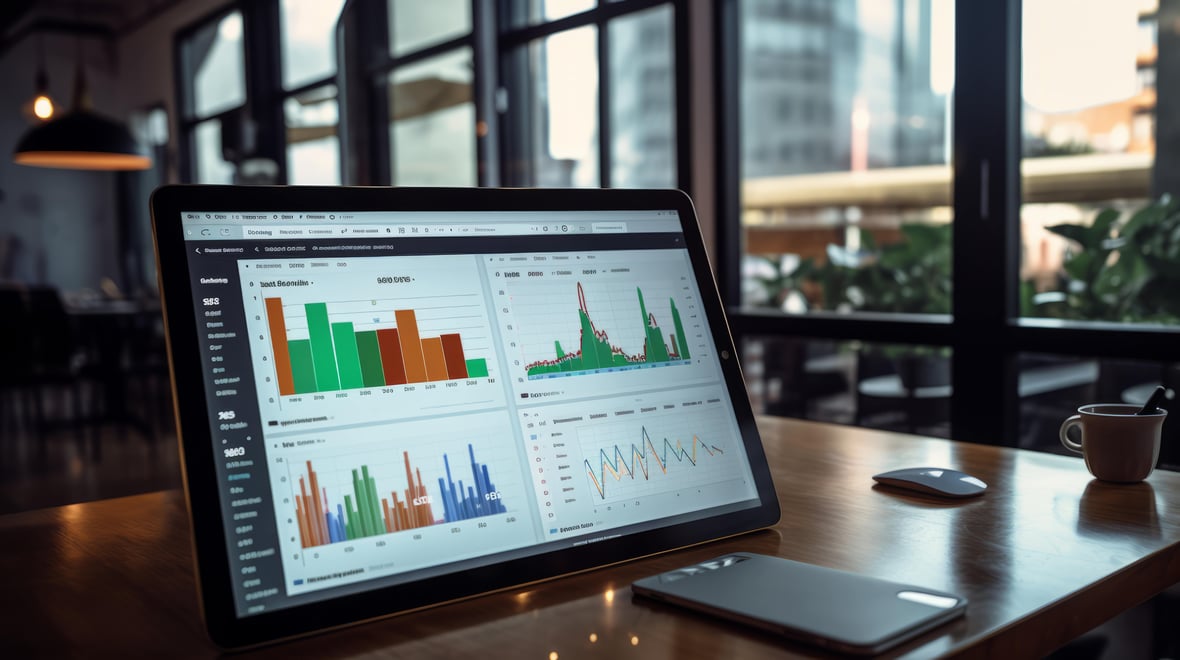
By Alen Čapelja
Benchmarking is the process of comparing an organization's processes, practices, products, or performance metrics to those of top-performing organizations or industry standards. It serves as a reference point to identify areas for improvement and understand how competitors or similar entities achieve higher performance.
Although benchmarking offers many advantages, it shouldn’t be the source of all decisions. Comparison with other organizations and their numbers can cause an organization to lose sight of its efforts and goals—and even make mistakes in attempting to replicate results. Therefore, benchmarking should be balanced with the many other tools in an organization’s toolkit.
In this article, we break down the benefits of benchmarking, how benchmarks are used for e-commerce brands, and the best tools and platforms to collect data—plus, we recommend a group to join to compare your performance to those in your industry.
Gathering and Tracking Benchmarks for Growth and Profitability
The link between benchmarks and brand growth and profitability is crucial to understanding business performance, guiding decision-making, and shaping strategic direction.
For benchmarks to serve their purpose effectively, they must be accurately gathered, tracked, and analyzed. Regularly monitoring benchmarks ensures that data is up to date and reflective of current market conditions. This allows brands to:
- Make informed decisions based on real-time insights.
- Quickly identify and act upon emerging trends or shifts in the market.
- Adjust strategies in response to changing performance metrics.
- Communicate performance effectively to internal teams and external stakeholders.
- Validate strategies and initiatives by measuring outcomes against set benchmarks.
Ultimately, benchmarks act as navigational tools in the business landscape. By regularly gathering and tracking benchmarks, you can stay agile, proactive, and aligned with market demands.
The Benefits of Benchmarking
Evaluating your performance against industry standards and competitors can lead to a number of common benchmarking benefits, including:
Improving Performance
By comparing against top performers or best practices, organizations can identify gaps in their operations and set clear targets for improvement.
Setting Standards
Benchmarking helps set clear and realistic standards based on what's achievable by considering what others have already accomplished.
Staying Competitive
Knowing where you stand relative to competitors can help you better understand where your strategy needs improvement.
Innovating
Through benchmarking, organizations can discover new and efficient ways of performing they might not have considered before.
Improving Customer Satisfaction
Understanding the best practices in the industry can lead to the adoption of methods that enhance customer satisfaction, which is critical for retaining and attracting clients.
Realizing Cost Efficiency
Benchmarking can lead to identifying areas where costs can be reduced without compromising quality. By analyzing how top-performing organizations operate, companies can adopt more cost-effective strategies and processes.
Enhancing Decision-Making
Benchmark data provides an objective, empirical basis for making decisions, rather than relying solely on intuition.
Validating Performance
If an organization is already performing at a high level, benchmarking can validate success and give stakeholders (such as investors or board members) confidence in the company's position.
Making Improvements
Regular benchmarking can foster a culture of continuous improvement, ensuring that organizations don't become complacent and always strive for better results.
Gaining an External Perspective
Benchmarking provides an external perspective, helping organizations look beyond their internal views and consider how they fit into a larger industry context.
Identify Crucial E-Commerce Benchmarks
Not all benchmarks will be relevant to every organization. Every e-commerce business is unique in the value and services it provides, so understanding and identifying the right benchmarks is important for success.
For e-commerce businesses, common metrics include:
Conversion Rate
Conversion rate is the percentage of website visitors who make a purchase. It's a key metric to understand the effectiveness of your website in converting traffic to sales.
Average Order Value (AOV)
Your AOV is the average amount spent by a customer during a single transaction. This helps your business understand customers' spending patterns.
Cart Abandonment Rate
Cart abandonment rate is the percentage of shoppers who add items to their shopping cart but do not complete the purchase. A high rate might indicate issues with pricing or the checkout process.
Customer Acquisition Cost (CAC)
CAC is the average cost to acquire a new customer, considering all marketing and sales expenses.
Customer Lifetime Value (CLV)
CLV is the projected revenue that a customer will generate over the course of their relationship with the business.
Site Traffic
This is the number of visitors to the e-commerce website, often broken down by source, such as organic, paid, referral, social, and others.
Bounce Rate
Bounce rate is the percentage of visitors who leave the website after viewing only one page. A high bounce rate might indicate irrelevant traffic or poor landing page experiences.
Retention Rate
Retention rate is the percentage of customers who continue to buy from the website in a given time frame after their first purchase.
Churn Rate
Churn rate is the percentage of customers who stop buying from the website in a certain time frame.
Net Promoter Score (NPS)
An NPS measures customer satisfaction and loyalty, calculated by asking customers how likely they are to recommend the business to others.
Revenue Per Visitor (RPV)
An RPV is the average revenue generated by each visitor to the site.
Mobile vs. Desktop Sales
This is the percentage of sales coming from mobile devices compared with the number using desktops, which can shed light on mobile user experience.
Page Load Time
This is the average time it takes for a webpage to display fully. Slow times can negatively impact user experience and conversions.
Return Rate
Return rate is the percentage of sold items that customers return.
Email Open Rate
This is the percentage of email recipients who open an email from the company—an important metric for e-commerce email marketing campaigns.
Email Click-Through Rate (CTR)
A CTR is the percentage of email recipients who click on a link within an email.
Customer Support Response Time
This measures how quickly customer inquiries or issues are addressed, impacting overall customer satisfaction.
Klaviyo Benchmark Data Sources
For Klaviyo users, benchmarks can be found in a number of areas. Some are official reports from the platform, and others come from communities or partners of the platform.
Klaviyo's Official Reports
Klaviyo often releases industry reports and insights based on the aggregate data it collects, which can be useful for benchmarking, especially after major events, such as BFCM and the holidays. The platform also has its own benchmarking software that provides personalized benchmarks.
User Forums and Communities
The Klaviyo community provides a space for users to share their results and experiences with the product’s numerous features.
Partner Agencies and Experts
Agencies that specialize in email marketing and particularly in Klaviyo might offer insights based on their experience with multiple clients.
Shopify Benchmark Data Sources
Similarly, Shopify benchmarks can be found in official reports from the company, communities, and partner agencies.
Shopify's Official Reports
Shopify regularly releases reports and insights based on platform-wide data. This might include information on average sales, conversion rates, and other relevant metrics.
User Forums and Communities
The Shopify community is vast, with many forums where groups and merchants discuss their performance metrics and share insights.
Shopify App Analytics
Many apps within the Shopify ecosystem provide analytics. By aggregating this data or by referring to user reviews and insights, one might gather some benchmarking information.
Partner Agencies
E-commerce agencies, especially those focusing on Shopify, might offer benchmark insights based on their diverse client experiences.
SmartBug’s Databox Benchmark Group for E-Commerce Clients
If you’re interested in finding benchmarks from a number of sources that include Klaviyo and Shopify, look no further than Databox.
Databox is a popular platform that aggregates data from various tools and platforms, allowing users to visualize and track performance metrics and benchmarks in real time.
When you join our benchmark group, you’ll be part of a community of 800 contributors in the industry. By viewing contributor data on the most important Klaviyo email metrics and Shopify sales metrics, you’ll discover how you stack up with others in the industry.
Join our benchmark group today to identify areas for improvement and perform at a higher level.
About the author
Alen Čapelja is SmartBug’s E-commerce Service Design Manager. He specializes in next-level problem solving and pushing the limits within the creative and client services departments. Alen employs a user-first approach that he’s refined after more than a decade of e-commerce work. Being part of executing more than a million emails in various ESPs has given Alen a broad understanding of e-commerce marketing and technology capabilities. Read more articles by Alen Čapelja.


















.png?width=200&height=260&name=E-Commerce%20Databox%20Group%20-%20CTA%20Image%20(3).png)



